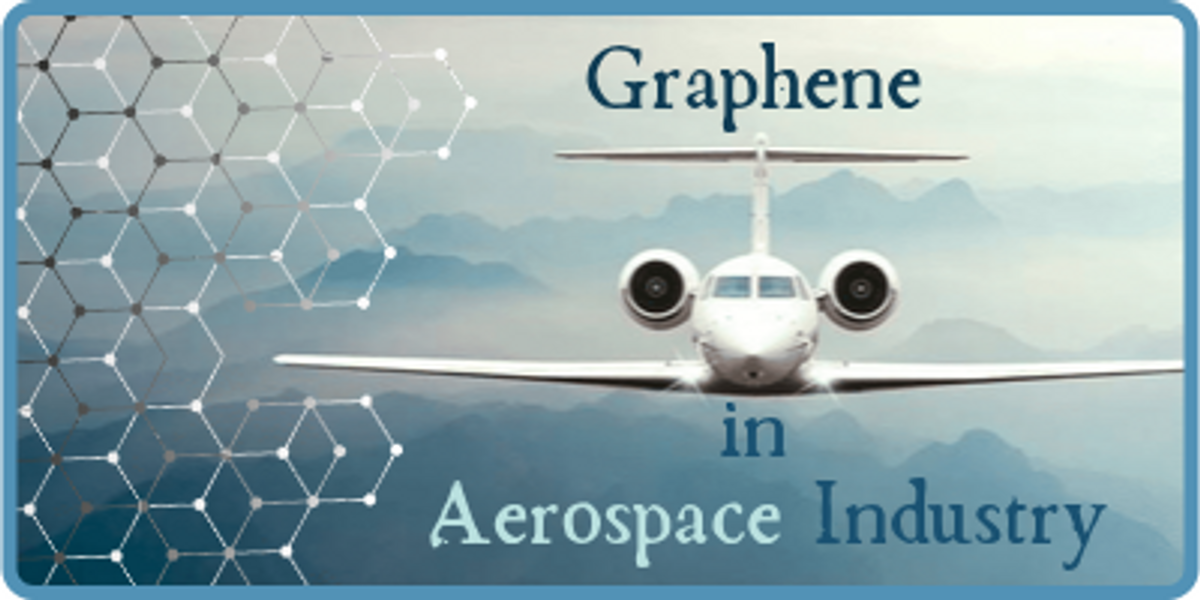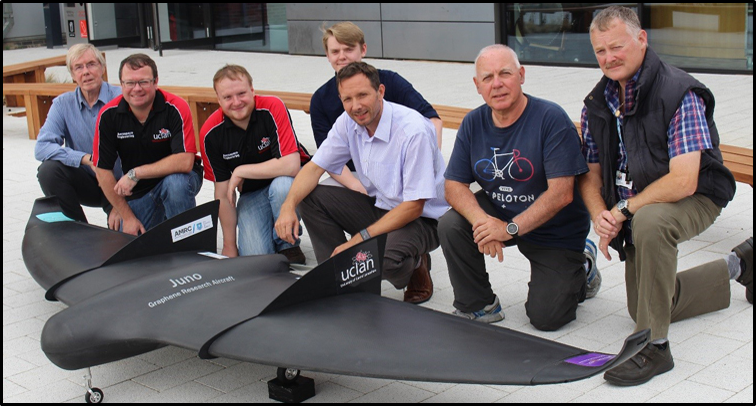Graphene's Use in the Aerospace Industry
Solar sails to travel between the stars. Space elevators to take satellites and astronauts into orbit without using an ounce of fuel. Lighter aircraft, helicopters, sturdy and invisible to radar. These are just some of the incredible applications of graphene, the wonder material made from a single layer of carbon atoms, in the aerospace sector. Graphene is revolutionizing not only Earth but also Space. The heat dissipation capacity of graphene allows producing ever smaller and more competitive for electronics and microelectronics products in aerospace sector. In the UK, University of Central Lancashire introduced Juno, an unmanned flying wing entirely covered with graphene. Lightweight, strong and flexible, the material is an ideal ally for aeronautics. Graphene has properties that could be useful in low gravity.
In the future, solar sails will probably be built to travel between the stars, space lifts to carry satellites and astronauts into orbit without using fuel, but also ultra-light, super-resistant and invisible to radar. Graphene, thanks to its high electrical conductivity, will be used not only to create de-icing systems integrated into the wings, but also to produce paints that reduce the radar footprint.
The key to the development of all these technological innovations is graphene, the 'wonder material'. This ultra-resistant material could have multiple applications in space technologies, according to recent tests conducted under the Graphene Flagship initiative. The main applications of Graphene in the aerospace sector, its history and several experiments conducted in recent years are discussed below.
Read: Ultimate Guide to Graphene: Everything You Need to Know About Graphene
Background
Graphene was discovered in 2004 by Andre Geim and Kostya Novoselov, professors of the University of Manchester (Nobel Prize Winners in Physics in 2010). It consists of a single layer of carbon atoms bound in a hexagonal pattern. Its features make it an excellent candidate for various applications in aerospace as well as in aeronautics: it is a million times thinner than paper and is 100-300 times stronger than steel.
Read about all applications of Graphene in this comprehensive post: 60 Uses of Graphene - The Ultimate Guide to Graphene's Potential Applications in 2019
Since its discovery, graphene provoked an immediate craze from the scientific community. It must be said the finest crystal known, which is found naturally in graphite crystals, is ultra-resistant, transparent and is an excellent conductor of electricity. These properties make graphene an ideal material for the electronics industry. A little more than fourteen years after its discovery, the applications based on graphene are widespread. Let’s have a look at some of them:
Applications of Graphene in the Aerospace Sector
1. Graphene’s Use in Solar Sails
Graphene, with its great mechanical strength and its lightness, is considered an excellent candidate for the realization of solar sails that will lead us to explore other star systems. In the future, we will be able to produce sails that will weigh only a few pounds and that can be safely deployed while maintaining their integrity.
2. Graphene Cable for Space Lifts
With graphene, you could also make the extremely resistant cable of future space lifts that will replace rockets. The cable, supported by a satellite in geostationary orbit, will allow lifting from Earth that will arrive in orbit without using an ounce of fuel, to carry astronauts, pieces of space stations, satellites, telescopes and equipment up to 36,000 kilometers high.
3. Graphene Cooling System for Satellites
Leonardo, an Italian aerospace company together with the National Research Council and the universities of Cambridge and Brussels conducted an experiment in 2017 for the first time regarding the use of graphene in microgravity to build cooling systems for satellites.
4. Graphene in Aeronautical field
The applications of graphene are also surprising in the aeronautical field. Graphene is already being used to create lighter and impact-resistant aircraft and helicopter structures. Thanks to the high electrical conductivity of graphene, it will also be possible to create de-icing systems integrated into the wings. Its shielding capacity will then make it possible to produce paints that reduce the radar footprint, to make the aircraft invisible but also to build wind farms that do not disturb the activity of radars that study air traffic.
5. Juno: Graphene-based Drone
In the United Kingdom, engineers from the University of Central Lancashire supported by industrialists unveiled a drone whose wing is fully coated with Graphene. The Juno aircraft was presented at the Futures Day event at the Farnborough Air Show 2018.
With a wingspan of about 3.5 meters, the wing made of a graphene coating is 17% lighter than if it had been covered with carbon fibers. As a result, its use makes it possible to increase the range of action and transportable load. Takeoff is also less energy-consuming. As a bonus, graphene has another advantage of avoiding the accumulation of ice on the wing at altitude. It can also deal with thunderbolt without flinching because of its high conductivity.
In addition to the graphene wing, the rest of the aircraft parts were printed in 3D. The researchers also loaded graphene batteries to lighten the whole. Recalling that such batteries, mixing lithium-ion and graphene, have been marketed to the general public in recent years. They do not heat up and can be recharged in record time.
The research team had already made the first flight of a graphene wing in January 2017. The laboratory also sent a high-altitude graphene capsule using balloons. The device presented to the public is the final step in a collaborative program between universities and industry. At the end of these experiments, the actors involved aim to develop research to exploit graphene in the aerospace industry.
Graphene Flagship Initiative and its Experiments
The Graphene Flagship initiative brings together 150 research laboratories in 23 countries with the support of the European Union and an endowment of one billion euros. The goal is to find opportunities for graphene in the aerospace and satellite industries. At the end of 2017, researchers of this initiative conducted two encouraging experiments which showed the potential of this crystalline sheet. The first one is "Zero-G" aircraft of the European Space Agency which flies a few minutes in weightlessness during a flight to the parabolic trajectory. It has made it possible to test the coating of some parts of heat exchangers which is made of graphene. These heat exchangers are commonly used in satellite cooling systems. The second experiment took place inside the freefall tower of ZARM University in Denmark and aimed to test the resistance of graphene sails that could equip future spacecraft moving around the world.
In both cases, the experiments were positive. Even if they are still in the domain of fundamental physics, they demonstrate the versatility of graphene and initiate possible industrial applications. As a part of the Graphene Flagship Initiative, the researchers teamed up with a private partner to develop a marketable heat exchanger.
Zero gravity Experiment
The largest European research initiative, Graphene Flagship, and the European Space Agency (ESA) worked together to evaluate the use of graphene in zero gravity conditions.
The researchers of the Graphene Flagship Initiative conducted an experiment in collaboration with the European Space Agency (ESA) to assess the potential of graphene for space applications. The experiment, which started in November 2017, tested graphene in gravity-free conditions aboard a parabolic flight to verify its use in thermal devices used in satellites.
The experiment investigated how graphene-based coatings can improve efficiency in heat exchangers, fundamental cooling systems used in satellites and instruments aerospace. The team met in Bordeaux, France, on November 2017 to test graphene-containing heat exchangers in microgravity conditions in a parabolic flight, managed by the European Space Agency (ESA) and Novespace (France).
The parabolic flight is the method used to bring the value of gravity close to zero without going into orbit, while the plane follows a parabolic trajectory, it can reach up to 25 seconds of weightlessness. Each flight, which lasted for 3 hours, involved about 30 parabolic arches. In addition to the absence of gravity, one also experiences the earth's gravitational force up to twice when the plane prepares itself for the next flight, as on a gigantic roller coaster.
Thermal management is very important in satellite management because the lack of air requires specific technological solutions to disperse the heat towards the deep space. High temperatures can compromise the performance of the electronics and of the instruments onboard. The temperature difference between two sides of a satellite, the one facing the sun and the one in the dark, can be extreme and can reach up to 200 degrees. The heat exchangers transfer the heat from the hot to the cold parts, and disperse the excess into space.
The research team intended to exploit the thermal and physical properties of graphene to improve the efficiency of heat exchangers. These in fact cool the devices on board thanks to the evaporation of a liquid that is inside a porous material structure, usually of metal. By replacing the metal material with a graphene-and-metal-based composite, researchers aimed to improve heat transfer between electronic units and the fluid that flows through them.
This greatly increased the interaction surface with the liquid, so that the heat can be transferred more evenly from the porous material to the fluid. The graphene-based foams also improved the capillary pressure of the porous material, allowing the fluid to move more quickly in its cycle through the entire heat exchanger. The capillary action, in fact, attracts the fluid towards the porous material, which in this way is continuously pumped and kept in circulation in the closed cycle of the exchanger device, providing a constant cooling.
Graphene is no doubt a wonderful material for the Aerospace sector. It combines strength, lightness, and flexibility, making it an ideal material for the Aerospace Industry. Graphene’s applications are being explored in the Aerospace Sector. Researchers at UCLan have prepared the first drone entirely covered with graphene. Moreover, due to the development of ultra-light and ultra-resistant solar sails, it would be possible to explore different star systems. The material can also be used to make a super-resistant cable for future space lifts that will replace rockets. By connecting the graphene rope to a satellite in geostationary orbit it will be possible to lift things from Earth that will go into orbit without using a gram of fuel. It will carry astronauts, pieces of space stations, satellites, telescopes and equipment up to 36,000 kilometers of height. The use of graphene has also been tested in microgravity to develop cooling systems for satellites. In addition, the material is already receiving positive feedback in the aeronautical field. Experts are working to make super light and resistant planes and helicopters.
Recent Posts
-
Advanced Materials for Unmanned Aerial Vehicle (UAV) Protection Against Laser
Consider a UAV on a critical mission, rendered inoperative by a sudden laser attack. With the increa …26th Jul 2024 -
Simulation and Modeling of Material Properties
Our world is composed of a dazzling array of materials, each with its own unique properties that dic …19th Jul 2024 -
Advanced Coatings for Superior Corrosion and Wear Resistance
Corrosion and wear pose significant challenges across various industries, leading to substantial eco …12th Jul 2024









